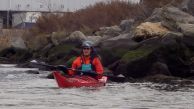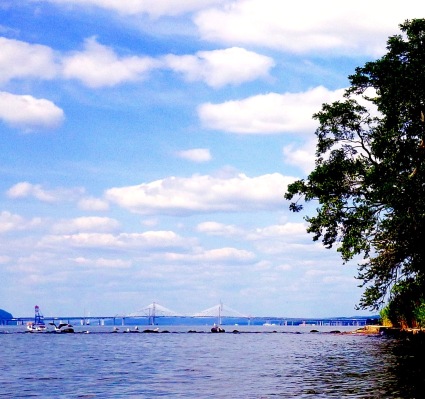
Johna in front of West Point
By Johna Till Johnson
“Glory, glory hallelujah!” My voice rang out strongly and surprisingly tunefully.
It was late morning, and I was just entering Peekskill Bay. The weather was perfect: Sunny, cool, with just enough breeze to generate a light chop. I felt my pace begin to pick up. A glance at the GPS confirmed it: I was going at least a knot faster than previously.

Ready to launch in the predawn at Denning Point
I’d discovered experientially that singing “Battle Hymn of the Republic” made me pick up the pace by a knot or so.
No other song seemed to have that effect. “Eddystone Light” was fun to sing (especially the part about life upon the ro-o-o-o-lling sea) but it didn’t make me any faster. And neither did the various popular songs I could remember bits and pieces of (“Roland the Headless Thompson Gunner” was a particular favorite).
So here I was out in Peekskill Bay, singing Glory Hallelujah to keep the pace going.
I’d left Denning Point before dawn that morning, paddling against the current as the sun slowly rose. By around 8:20 I’d arrived at West Point.

Predawn on the Hudson
Unbeknownst to me, so had my friend Adam. He and his wife were on the early train into Manhattan, just a few hundred yards from me. He snapped a photo through the window, guessing the lone paddler might be me from the drybag strapped on my rear deck (likely indicating someone camping, rather than on a day trip.)
Just after West Point the current finally turned with me, but I wasn’t picking up much speed. Apparently the days before had tired me out a bit, even the “easy” day yesterday.
That’s when I tried singing, and discovered that “Battle Hymn of the Republic” was good for at least an additional knot.

First view of West Point
It wasn’t just the rousing melody. The lyrics were inspiring, and even more so, the meaning. The writer, fellow New Yorker Julia Ward Howe, had created it to inspire Northerners to fight in a hard, ugly, brutal civil war that brought them no direct benefit.
Although I was hardly fighting a war, the idea of doing something difficult for the glory of it resonated.
The shoreline streamed by. The sun was bright, but there was a cool breeze providing a tailwind. As I made my way around the curve (the river makes a hairpin turn around Peekskill Point), I mentally computed the currents. I’d have the ebb with me until about 3:30 PM, by which time I’d be at the Tappan Zee bridge (or pretty close.)
Then the current would turn against me.
But how bad could it be? The flood was only a knot, maybe a knot and a half. And I’d paddled against the current before. Under normal circumstances it would take maybe 2 hours to get back to Yonkers from the Tappan Zee. So, okay, tack on another hour—I’d be home by 6:30, 7:00 at the latest. Right?

Looking at West Point. Two minutes later, Adam would photograph me…
Of course, there was the question of what happened after that. I’d blithely departed Hudson after making arrangements to leave my car at the B&B where I’d spent the night. The plan was to take the train home from Yonkers.
The catch? I didn’t know exactly where the train station was. There was rumored to be one within walking distance of the boathouse. But the instructions I’d heard were obscure and faintly ominous. “You go through the hole in the fence and climb up on the track.” (No guidance on where the hole in the fence was, or what, precisely, “climbing up on the track” entailed.)
I’d had the presence of mind to jot down the train schedule before I left, so I knew the train stopped at Glenwood en route to Manhattan every hour at 26 minutes past. But finding it would be the trick.
There was the distinct possibility of ending up wandering around Yonkers in the dark with a bunch of camping gear on my back, looking for the mysterious hole in the fence.
Oh well, that was a long way off. And meantime, there was paddling to be done!
Glory, Hallelujah….
I made decent time, and by 3:30 I’d reached the Tappan Zee.

The route home. The “tiny” jig left was where I got out of the current…
As anticipated, the current had just changed, and was ever-so-slightly against me. Annoyingly, so had the wind, which was now coming from its usual direction, southwest. (Vlad : “Murphy’s law of kayaking is that the wind and current are always against you.” Also known as “Florida rules”.)
South of the Tappan Zee, the Hudson is shallow and marshy on the western shore, so that’s where I headed. Generally the current flows more slowly in the shallow parts of a river; and near the shoreline a paddler can take advantage of the back-eddy (where the current strikes protrusions on the shoreline and bounces back, thus going in the opposite direction to the main current).
With these tricks, even with the opposing wind and current, I was able to keep a good 2-3 knot pace, but there was a catch: I wasn’t headed straight home. Instead, to keep out of the wind and stay in the backeddy, I was making a long detour; I estimated it would add two-and-a-half or three miles to the trip. Which meant… another hour.
Now I’d arrive closer to 8 PM than 7 PM, if all went well.
I’d gone over 30 nautical miles by then, and I was feeling it. I paddled strongly, but didn’t manage to do much better than 3 knots. Slowly, the beautiful waterfront houses on the western shore slipped by. Ahead was Piermont Pier, a long spit of land reaching into the Hudson.
One summer, Vlad and I had made an overnight, full moon paddle to Piermont Pier. It’s still one of my most vivid memories. I remember napping on the benches, waiting for the current to change, watching the full moon touch the dark waves with shimmering silver. Dozing.
Vlad shaking me awake, gently: “Come on Johna, it’s time to go.” Paddling back to Manhattan in the gray pre-dawn, arriving at Pier 40 just as the sun was rising…
I’ve been to Piermont Pier a few times since, but it’s always inextricably entwined in my memory with silvery moonlight and dark waves. And Vlad.

Pollepel Island in the early morning
This time couldn’t have been more different. The sun was already low in the sky when I arrived, touching everything with honey-colored light. I turned east at the pier. Sheltered from the current, I was speeding along the length of the pier with the wind at my back, barely needing to paddle.
I marveled at the mix of people out enjoying the late Sunday afternoon. Hispanic families fishing. Orthodox Jewish families taking babies for a stroll. Young couples holding hands. Children waved at me, and I waved back.
Soon enough I’d rounded the pier and turned south again, hugging the shoreline of Piermont Marsh. For the first time my destination was visible in the distance: The twin brick towers of the abandoned power plant just behind JFK marina. It was probably still another hour or two away, but I was almost home!
In the peaceful late-afternoon light, I continued on down the western shore, taking advantage of the backeddy. Past Italian Gardens. Past the rockfalls on the Palisades.
Finally I decided to cross. Too early, as it turned out: The current swept me backwards, and I watched in frustration as landmarks that I passed earlier reappeared. But finally I was across. As the rosy sky began fading to darkness, I wended my way down the shoreline.
Soon there was the buzz of jetski engines, and the thumping sound of music, growing steadily louder.
New problem: the ramp was crowded.

Everyone was pulling jetskis out of water, backing trucks and trailers up to the ramp impatiently. I wouldn’t be able to unpack the boat on the ramp. But it was too heavy for me to carry up without unpacking.
Salvation! One of the guys who manned the marina office appeared, a young man around twenty, with tattoos on both arms. He helped haul the boat to a nearby stretch of grass.
I unpacked as quickly as I could in the gathering darkness, throwing all the camping gear into a giant waterproof backpack that I’d discovered among Vlad’s things. (I had one as well, but this one was nearly twice the size).
Staggering a little, I was able to lift to stand up wearing the pack. I mentally thanked my coach and the months of squats and deadlifts in the gym, then grabbed the nose of the boat (which was already mounted on its wheels) and started off towards the boathouse a quarter mile away. Around me, music blared, styles competing with each other at full volume. Latin. Hiphop. Soft rock. A running undertone was the monotonous jingle of the ice cream truck.
Suddenly the darkness was cut with red-and-blue flashing lights and amplified voices. Yonkers PD had arrived to clear everyone out of the park.
I chuckled at the difference between the previous peaceful days and this in-your-face urban vibe. I loved them both.
I packed up as quickly as possible, leaving most of the camping gear and stuffing just essentials into a small backpack (yes, I have lots of backpacks!)
Now what? It was full dark, and the woods behind the abandoned power plant didn’t look inviting. And Yonkers is an urban area (just north of the Bronx.)
Luck had been on my side the whole trip. Surely it would stay through the end?
I decided to check it out, and plunged into the darkness, lit only by the headlamp. A few minutes later, I was delighted to find…. Not a hole in the fence, but a wide-open pathway leading directly to the station. A few minutes’ investigation yielded the delightful fact that a short ladder climbed the six feet or so to the platform’s edge.
I sat down on the bench to wait, feeling pleased. Glory Hallelujah….
Just over an hour later I was back in my apartment in New York, much to the delight of my cat Mully.
And the next day the email from Adam arrived, with the subject header: “Is this you?”
Indeed it was! One of the few photos of me on an expedition paddle, now that Vlad is gone.
Glory Hallelujah!

Yonkers at twilight
Special thanks to Henry at YPRC who gave me the encouragement to finally finish this, reminding me that at least one person is reading! Thanks, Henry!

















































































